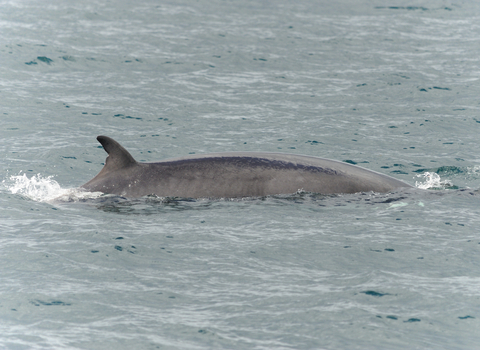
Minke whale ©Amy Lewis
Minke whale
Scientific name
Balaenoptera acutorostrataWhen to see
January to DecemberSpecies information
Category
Statistics
Length: 7-9m Weight: 5-10 tons Lifespan: 40-50 yearsHabitats
About
The Northern minke whale, most often referred to as the minke whale in the UK, is found throughout the oceans of the Northern Hemisphere. They are markedly smaller than the other baleen whales found in UK seas, though it is sometimes difficult to judge size at sea! Minke whales are generally spotted alone or in small feeding groups feasting on schools of fish or krill. They are what is known as a "gulp feeder", meaning they take a huge gulp of fish and push the seawater out through the baleen plates that line their mouths. You can sometimes spot minke whales lunge feeding into a school of fish near the surface.How to identify
A small streamlined rorqual whale reaching an adult length of 7-9m. Minke whales have a sleek, dark grey body and a tall sickle shaped fin that curves backwards. Look out for the distinctive white "armbands" on the pectoral fins (front flippers). Their blow is weak or invisible.Distribution
Can be spotted in near-shore waters around the UK, though rare in the Southern North Sea and English Channel.In our area
Scilly's seas abound with wildlife, including a variety of cetacean species including minke whales, common dolphins, harbour porpoises and even bigger species like humpback and fin whales. One of the best ways to see marine mammals is to watch from Scilly's many headlands (like Peninnis or Deep Point on St Mary's, Wingletang on St Agnes, Shipman Head Down on Bryher, Castle Down on Tresco or from the Daymark on St Martin's) or to head out on a WiSE accredited boat operator offshore. Cetaceans don't generally come between the islands, so a trip to the Western Rocks, Eastern Isles or beyond will give you the best opportunities to see them. You can also spot plentiful wildlife on the Scillonian III crossing from Penzance with Isles of Scilly Travel.
Did you know?
Minke whale vocalisations can be as loud as 150 decibels - that’s the same as a jet plane taking off! This allows them to communicate over long distances underwater.Scilly's seas abound with wildlife, including a variety of cetacean species including minke whales, common dolphins, harbour porpoises and even bigger species like humpback and fin whales. One of the best ways to see marine mammals is to watch from Scilly's many headlands (like Peninnis or Deep Point on St Mary's, Wingletang on St Agnes, Shipman Head Down on Bryher, Castle Down on Tresco or from the Daymark on St Martin's) or to head out on a WiSE accredited boat operator offshore. Cetaceans don't generally come between the islands, so a trip to the Western Rocks, Eastern Isles or beyond will give you the best opportunities to see them. You can also spot plentiful wildlife on the Scillonian III crossing from Penzance with Isles of Scilly Travel.
